Preparing to bring home a Pekingese puppy? If so, you’re likely eager to learn as much as possible about taking care of this unique breed.
In this guide, we’ll cover Pekingese progression, including milestones, a growth chart, and training tips to help you on your journey to raising a healthy, happy pup!
Read on to learn more.
Pekingese: Breed Summary
While ascertaining the place of origin of some dog breeds can be quite tricky, this is not the case with the esteemed Pekingese. Native to China, the Pekingese is one of the world’s most ancient breeds. Historians of the breed place their origin to about 2,000 years ago as canine companions of the Chinese imperial family. Only those in the Emperor’s high court were allowed to own these noble dogs. In China, the Pekingese is often referred to as the “lion dog” or the “little lion dog” for its resemblance to Chinese guardian lion statues. Even its various coat colors were created to match various robes of the imperial family. The name, Pekingese, refers to the city of Beijing, which Europeans called Peking, home of the Forbidden City.
This breed was isolated to China until 1860 when British and French soldiers ruthlessly destroyed 800 acres of imperial gardens and palaces during the Second Opium War. In the Old Summer Palace, soldiers found five Pekingese and promptly carried them off to England where they were presented to members of the British royalty. The Duchess of Richmond, Lady Algernon Gordon-Lennox, bred her pair, beginning the practice of Pekingese breeding outside of the Chinese imperial family.
Breed Standards and Attributes
According to AKC breed standards, the Pekingese should be an overall well-balanced, small, sturdy dog with a head that is quite large in proportion to the body. The dog should be slightly larger than tall and his face should be prominent, broad, and flat. The skull is wider than it is deep and the neck is quite short and thick. The coat is long, with the outer coat coarse in texture and the undercoat soft. The overall look should be lion-like and exude boldness.
While genetics can play a role in influencing the personality of a dog, several other additional factors are just as important in affecting the development of an individual pup. These include stress levels of the mother dog while pregnant, interactions with littermates and the mother dog, physical health, early socialization experiences, if species-specific needs of the dog are met while growing up, and the type of bond expressed between the pup and the primary human caregiver.
With these factors in mind, the characteristics often attributed to the Pekingese include:
- intelligence
- aloofness with strangers
- independence
- courageous
- highly affectionate with family members
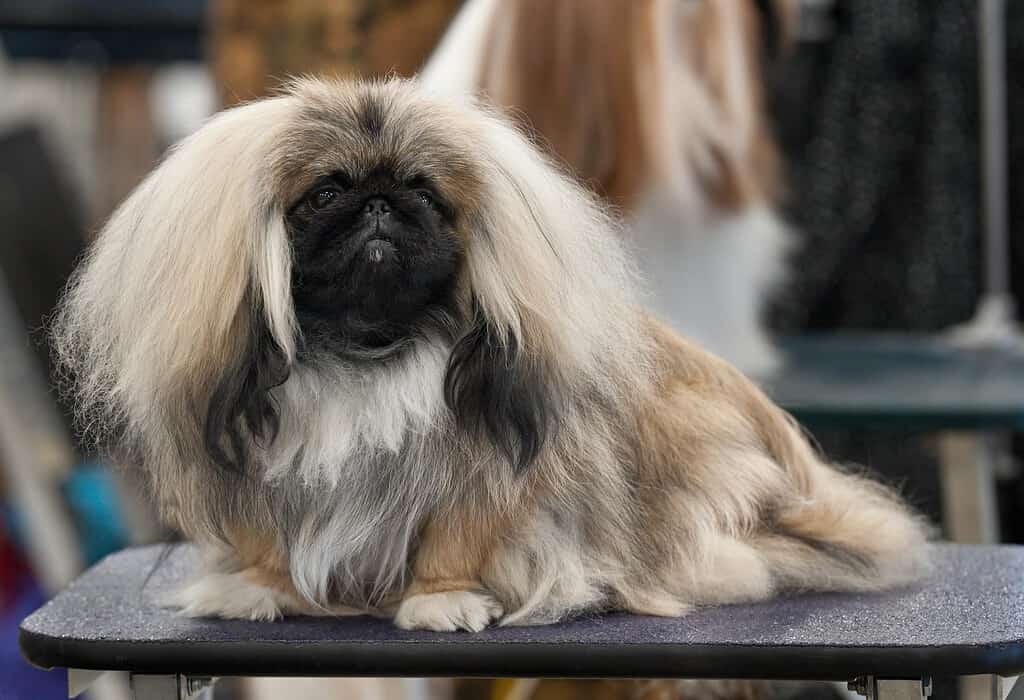
Originating in China, the Pekingese is one of the most ancient dog breeds in the world.
©SheltieBoy, CC BY 2.0 <https://creativecommons.org/licenses/by/2.0>, via Wikimedia Commons – Original / License
Pekingese Progression: Growth Chart
The following chart provides an estimate of your Pekingese’s weight as they grow from 2-8 months. Please note that this chart provides an estimation. Genetics and diet can cause variations from this standard. According to the AKC, male and female Pekingese are in the same weight range.
| Pekingese Age | Pekingese Weight |
|---|---|
| 2 Months | 1.5-2 lbs |
| 3 Months | 2-4 lbs |
| 4 Months | 3-6 lbs |
| 5 Months | 4.5-7 lbs |
| 6 Months | 5-9 lbs |
| 7 Months | 5.5-11 lbs |
| 8 Months | 6-13 lbs |
| 9 Months | 6-14 lbs |
When Will My Pekingese Stop Growing
As a toy breed, you can expect your Pekingese puppy to reach their full size around 8-9 months old. Pups in this size category reach physical maturity much faster than larger breed dogs. Scheduling regular check-ups with your vet as your puppy grows is a great way to make sure your Pekingese puppy is on track developmentally. When fully grown, a dog this size will need to consume about 300-400 calories per day, depending on their activity level. Always make sure fresh water is available to your pup.
Pekingese Progression: How Big Will My Pekingese Be When Fully Grown
According to the AKC, a Pekingese should weigh no more than 14 pounds. On average, you’ll find that most purebred adult Pekingese weigh 7-14 pounds. These little lion dogs should measure 6-9 inches tall at the shoulder. You may find that diet and genetics can result in a deviation from these standards.
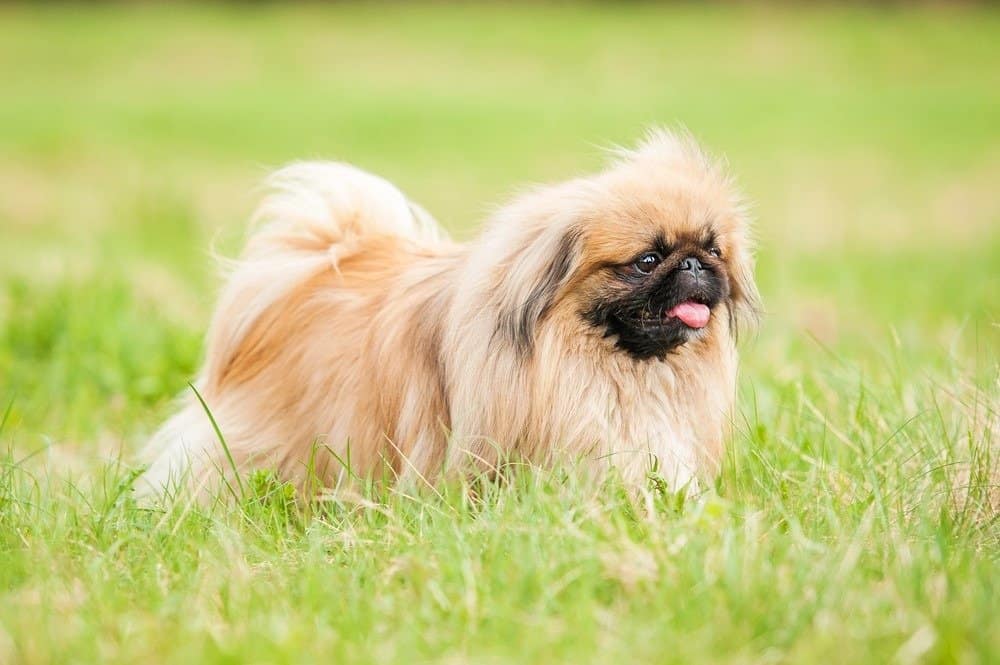
When fully grown, your Pekingese will likely weigh 7-14 pounds, and measure 6-9 inches tall at the shoulder.
©Rita_Kochmarjova/Shutterstock.com
When Should My Pekingese Be Spayed or Neutered?
There’s no one-size-fits-all answer to the question of when to spay or neuter your dog. Spaying and neutering (both procedures referred to below as “altering”). Modern research shows that an increased risk of negative health effects from altering can vary largely based on the breed and size of your pup. Some breeds, such as golden retrievers, face an increased risk of developing joint diseases such as hip dysplasia, from altering under 1 year old. Other breeds, such as the Cavalier King Charles spaniel, don’t appear to face increased risks of joint disorders or cancers from early spay or neutering.
Since the Pekingese is not a common dog breed, there is not widespread data available regarding the best time to alter your pup. It is important to note that small breeds in general, with only a couple of exceptions, tend to fare better with altering at under 1 year than large breed dogs. Your best course of action is to speak to a veterinarian who is informed on the latest spay and neuter research.
Pekingese Progression: When Should I Potty Train My Pekingese Puppy?
You can begin potty training your Pekingese puppy as soon as you bring them home. For most people adopting a puppy, this is at a minimum of 8 weeks old. You’ll want to practice patience and consistency while helping your puppy learn where to use the bathroom. Puppy pads are an excellent tool to help your pup transition from indoor to outdoor bathroom use.
If you use a large enclosure for your puppy or gate or areas of the house, it’s important to allow plenty of space between where they eat and sleep and where the puppy pads are placed. Puppies can only hold their bowels and bladder for short periods of time, so it’s important to provide bathroom breaks about every 2 hours and make sure they have room to eliminate on puppy pads away from where they rest, play, and eat. You’ll also want to take them outside immediately after they eat their meals and drink water.
Provide plenty of praise when they go to the bathroom on their puppy pads or outside. If they have an accident inside, it’s crucial to not scold or otherwise punish your puppy. This punishment will only serve to damage your relationship, confuse your puppy, and even lead them to hide where they go inside to avoid punishment.
When Should My Pekingese Stop Eating Puppy Food?
Your Pekingese puppy will reach physical maturity quickly, so you can begin transitioning them over to adult food much sooner than with larger breed dogs. For toy breeds, you can start switching your pup over to adult food at 6-8 months of age. It’s important to not switch sooner than this age range. Your Pekingese needs the calorie-dense nutrients and high protein levels found in puppy food as they are developing. As their metabolism and development slow down, they can switch to lower protein and lower calorie-dense food.
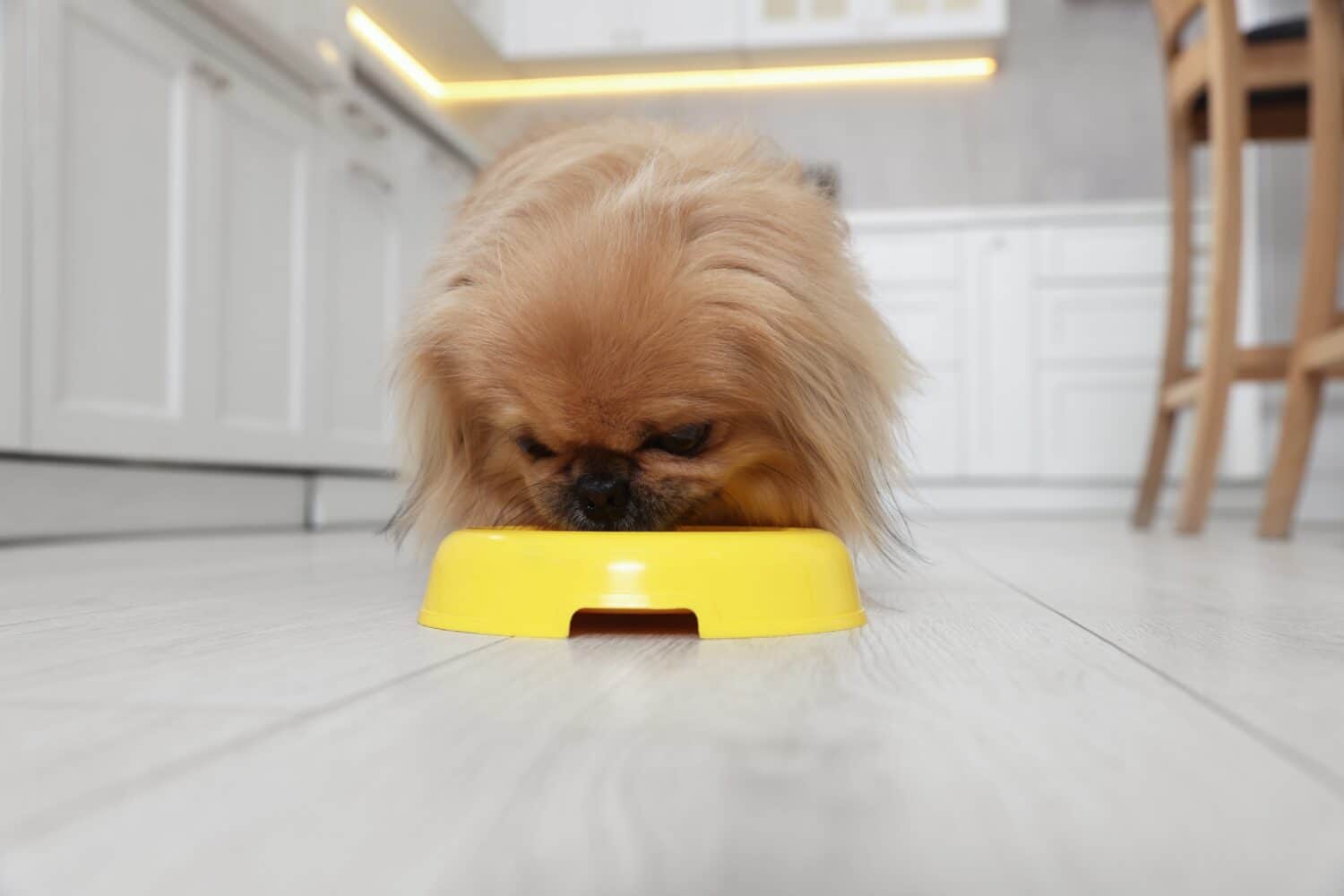
You can begin transitioning your Pekingese to adult food at 6-8 months of age.
©New Africa/Shutterstock.com
Pekingese Progression: When Will My Pekingese Puppy Start Losing Teeth?
Across all dog breeds, puppies start losing their set of 28 baby teeth around 12-14 weeks old. During this time, this primary set of teeth falls out and permanent, adult teeth begin replacing them. By about 6 months old, your Pekingese pup should have a full set of 42 adult teeth.
During the process of losing baby teeth and growing an adult set, your pup will likely want to chew on items to soothe their gums. This is an entirely natural and appropriate response. It’s important to provide them with a range of safe items of various textures to chew on. You also may need to gate off certain areas of the house. Additionally, put important and unsafe items in unreachable areas.
Trade, Don’t Take!
If you find your Pekingese puppy chewing on an unsafe or important item, it’s important to swap the inappropriate object with a toy. If you only take items away from your puppy, you can cause your puppy to distrust you. This can lead to resource guarding, defensive behaviors, and swallowing items. To prevent a damaged relationship and this cascade of difficult behaviors, just make sure to offer an item equally as good or better than the one you are asking your puppy to drop.
When Should I Start Training My Pekingese Puppy?
Once your Pekingese puppy is 8 weeks old, you can begin teaching them skills that will help them live happy, safe lives in our weird, human-dominated world. At this age, training sessions should only be 2-3 minutes long. At all stages of your pup’s life, it’s important to facilitate fun, enjoyable education that your pup wants to engage in and makes sense for their species.
While it’s understandable to want to get started on training your puppy, it’s crucial to prioritize forming a secure attachment bond and start an early socialization program from 8-12 weeks of age. Moreso than teaching cues, establishing a secure bond and gently introducing your puppy to new, positive experiences will help develop a well-rounded, confident dog. Since this breed has a long double coat, it’s crucial to help them feel comfortable with being groomed from a young age. Your Pekingese will likely need a thorough brushing session every week and a trip to the groomer every 4-8 weeks.

Gently introducing your Pekingese to new experiences as a puppy will help them become a well-rounded, sociable adult.
©Ermolaev Alexander/Shutterstock.com
Pekingese Progression: What Cues Should I Teach My Pekingese Puppy First?
The best training mixes education with relationship-building. This education should be fun and voluntary. A good question to ask yourself when thinking about what cues to teach your Pekingese is- Does this skill fill a species-specific need or benefit my dog as an individual? One of the first skills you can teach your puppy that will help keep them safe throughout their life is to recall.
Teaching a recall cue can also help strengthen your relationship as every time your Pekingese puppy comes when you call, they receive lots of snuggles, toys, and treats. To start teaching this cue, you’ll want to begin only a couple of steps away from your puppy. Gently gain their attention. Encourage them to come to you either with a treat, by squeaking a toy, or just using an inviting, cheerful voice. When your puppy comes up to you, give them lots of praise, affection, a toy, or a treat.
Another important cue to teach your Pekingese puppy early on is “Watch me”. This breed of dog can be quite independent. So, it’s important to facilitate their interest in paying attention to you when asked under reasonable conditions. You can begin teaching this skill by drawing your puppy’s attention to your face with a treat. As they move their eyes to follow the path of the treat towards your face, say “watch me” in a pleasant, bright tone, and then immediately give them a treat for looking at you. Eventually, you can transition to saying “Watch me” as the cue for your pup to look at you. Some dogs aren’t comfortable with looking in our eyes. If this is the case for your Pekingese puppy, simply reward them for looking toward your face.
When Will My Pekingese Calm Down?
When people first bred Pekingese dogs, they sought to create a dignified lap dog and companion canine for the imperial family of China. Those who had these regal pups wanted a dog content to lounge. Today, they retain a reputation as a loving, affectionate lap dog with low to moderate energy. You may find that your Pekingese puppy is playful, but not overflowing with energy. Of course, breed attributes are never a hard and fast rule. However, it’s likely that your pup will begin to settle into a calmer demeanor by around 16-18 months old.
If your puppy is having difficulty settling, it’s important to not chop this up to “bad behavior”. If your pup’s species-specific needs aren’t met or they have an underlying medical issue, they might display hyperactive behavior and restlessness as symptoms. Make sure to provide your Pekingese with consistent access to social companionship, mental and physical enrichment, nature, a comfortable and quiet resting area, and as much autonomy as possible.
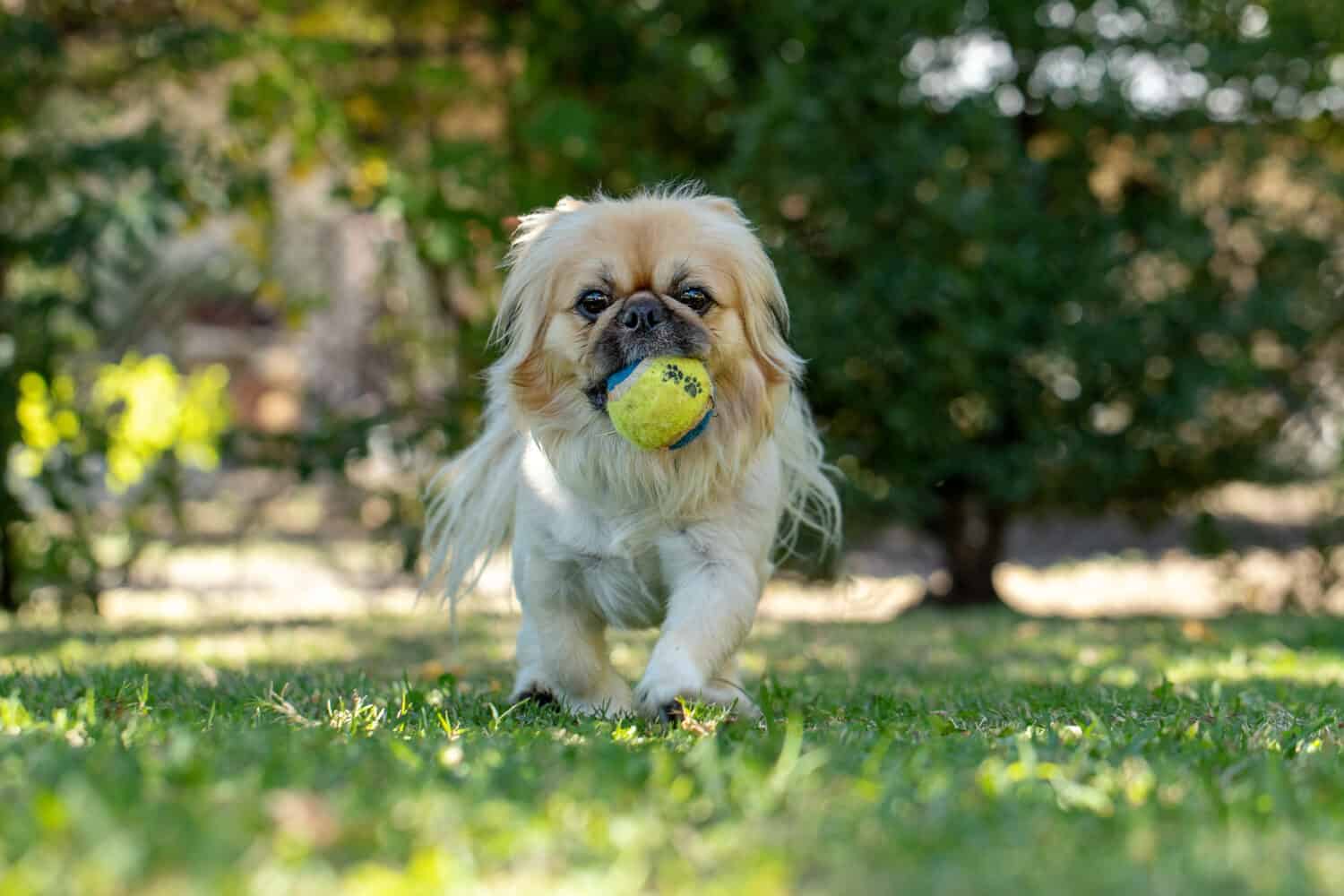
Providing your Pekingese with consistent enrichment, rest, companionship, and healthy food is the best way to ensure they can feel relaxed and content.
©AJ Laing/Shutterstock.com
Pekingese Progression: Common Health Issues Your Pekingese Might Experience
Purebred dogs are typically more prone to developing inherited health conditions than their mixed-breed counterparts. Genetic testing can help determine what risks your specific pup might face. If you are adopting from a rescue and don’t have access to information on your Pekingese’s lineage, it’s especially important to know what health conditions that breed faces in general. Like most toy and small breed dogs, they have a life span of about 12-15 years.
Overall, the Pekingese is considered a healthy breed. Although, they do still face an increased risk of some inherited conditions typical of small dogs and pups with short muzzles. These conditions include the following:
- intervertebral disc disease (IVDD)
- luxating patella
- brachycephalic airway syndrome
- progressive retinal atrophy
- hip dysplasia
- allergies
- heart disease
- dental disease
If you notice any sudden changes in the behavior of your Pekingese pal or clinical signs of a health condition, it’s best to set up an appointment with your vet as soon as possible.
Picture of a Pekingese Puppy
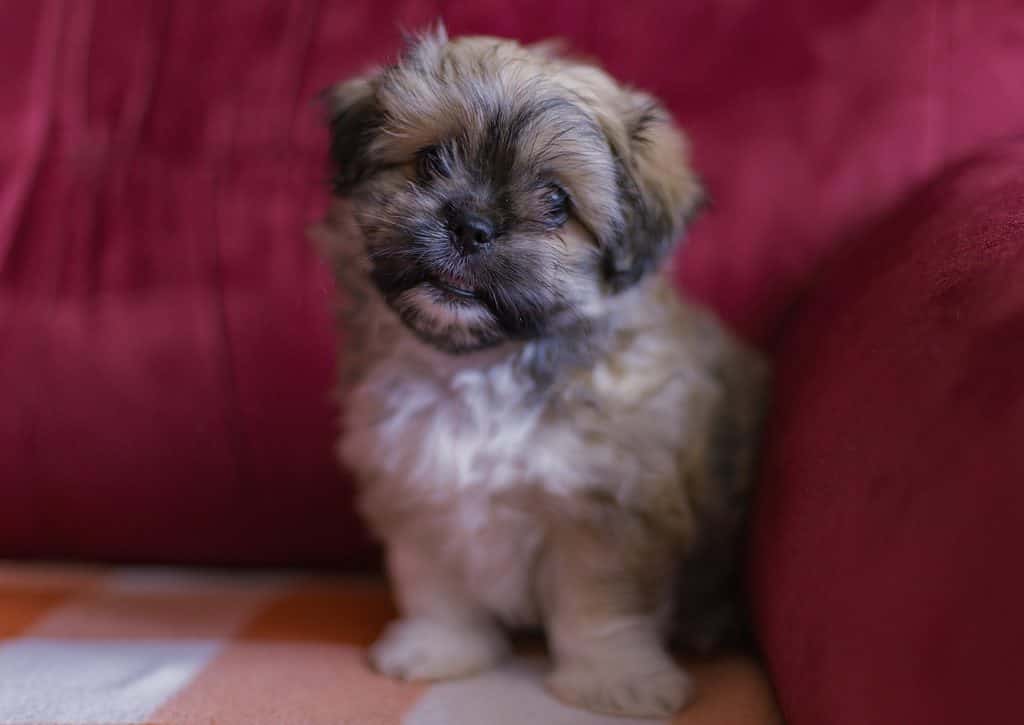
An adorable Pekingese puppy.
©ssputnik/Shutterstock.com
Picture of a Pekingese at 6 Months
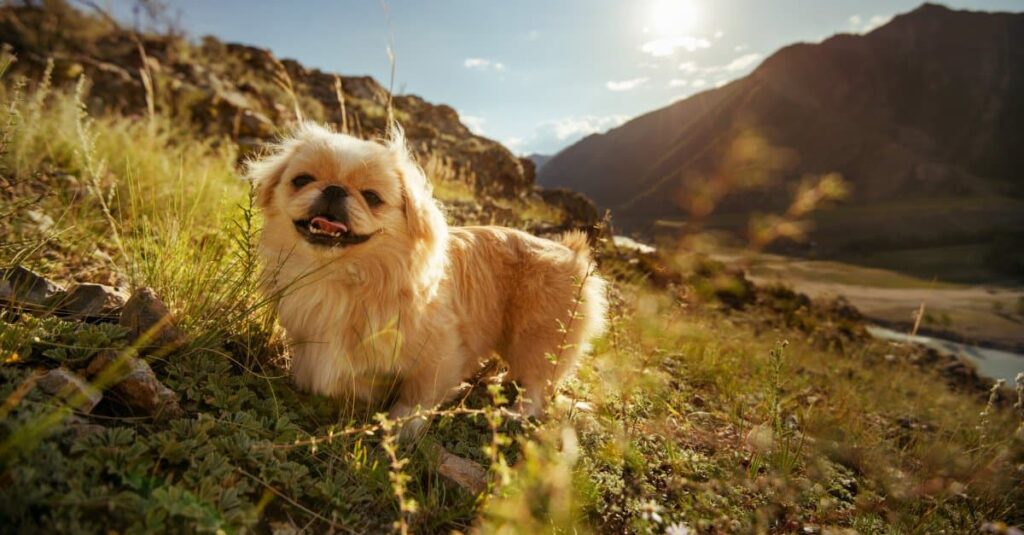
At 6 months old, a Pekingese is almost fully grown.
©iStock.com/molchanovdmitry
Picture of an Adult Pekingese

An adult Pekingese can grow a floor-length coat.
©Lilly M, CC BY-SA 3.0 <http://creativecommons.org/licenses/by-sa/3.0/>, via Wikimedia Commons – Original / License
The photo featured at the top of this post is © DejaVuDesigns/Shutterstock.com
Ready to discover the top 10 cutest dog breeds in the entire world?
How about the fastest dogs, the largest dogs and those that are -- quite frankly -- just the kindest dogs on the planet? Each day, AZ Animals sends out lists just like this to our thousands of email subscribers. And the best part? It's FREE. Join today by entering your email below.
Thank you for reading! Have some feedback for us? Contact the AZ Animals editorial team.







